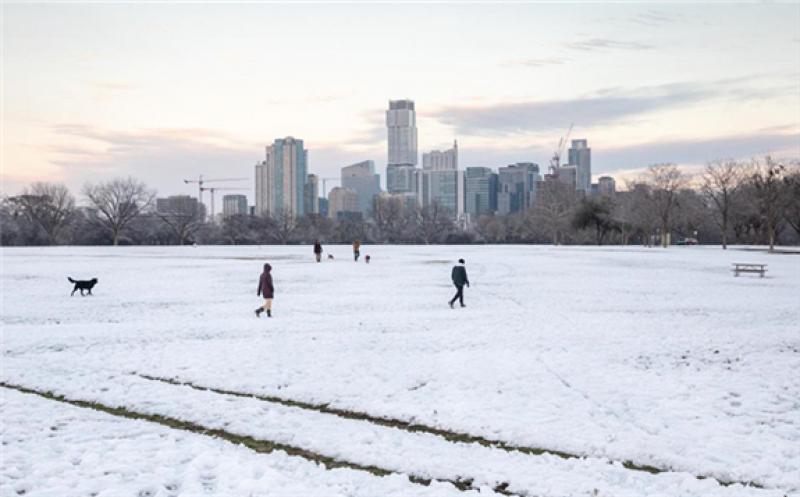The state at the centre of American “energy dominance” cannot even keep the lights on or houses warm. The harsh winter weather that struck Texas led to a cascade of failures: power cuts, gas and water disruptions, clogged sewage pipes, petrol and food shortages and about 60 deaths.

This tragedy has three important lessons, even for countries where winter weather is never more severe than just rain.
The first lesson is that climate change will increasingly pose extreme weather events that threaten the energy system. Last year, probably the hottest on record, brought wildfires in Australia and California and a severe Atlantic hurricane season. Iran and Iraq have repeatedly been struck by heatwaves and drought in recent years, interrupting electricity supplies as dams run low.
Conversely, a Russian liquefied natural gas tanker this month embarked on the first voyage by a commercial ship through the Northern Sea Route, around the top of Siberia, to China – a route normally blocked by impassable ice.
Now, warming has weakened the polar vortex that typically keeps cold air confined around the Arctic, allowing freezing temperatures to spill south to Texas.
The second lesson is the need for resilience in the face of such weather surprises, natural disasters, technical failures, sabotage, cyber attacks, embargoes or any other such dangers.
The trouble in Texas resulted in drastic cuts in oil production and refining. The state’s floundering governor attempted to stop the movement of gas out of the state, potentially cutting off Mexico and LNG export plants.
The Electricity Reliability Council of Texas, or Ercot, operates the state’s electric grid and manages its deregulated market. The current disaster may be the most severe but this is not the first time that cold weather has disrupted electricity supply – there were also power cuts in February 2011 and December 1989.
It seems that recommendations made then were not followed up. Power plants of all kinds – whether gas, nuclear or wind – were not built to cope with harsh winters.
Wind turbines, which operate perfectly well in frigid temperatures further north, iced up while gas and steam turbines were exposed on open roofs.
Worse – and this has been more of a surprise – gas fuel, which is at the beating heart of the US energy industry, went missing. Gas wells froze and gas-fired plants did not have diesel tanks on site to act as emergency back-up.
In a cycle of failure, as electricity generation declined, supplies to gas-processing plants and pipeline-compressor stations were not prioritised, forcing gas production and deliveries to drop even further.
The third lesson is the need to carefully plan for such resilience in an energy system undergoing radical change. The vision for most plans to tackle climate change is to shift to mass electrification of most end-user products as possible – battery cars, electric heat pumps and air conditioning. That electricity will be provided by solar, wind and hydroelectric power sources and, perhaps, some legacy nuclear plants.
Texas may be the “Saudi Arabia of wind” but most of the state’s electricity still comes from fossil fuels and nuclear. As with last summer’s power disruptions in California, right-winger bloviators reduce a complex set of failures, unanticipated conditions and mismanagement to a simple narrative: that renewable energy is unreliable.
That was not the cause of the Texan problems: Ercot knew that wind and solar generation in the state is usually low in winter and was not counting on it.
As the cold front moved in, expected demand rose to about 77 gigawatts. Early in the morning of February 15, thermal generation – gas, coal and nuclear – suddenly collapsed from 58 gigawatts to 48 gigawatts as power plants and gas supplies froze up.
It kept falling until it reached a low of less than 37 gigawatts the next day. Meanwhile, renewable output dropped from 5.5 gigawatts overnight to less than 1 gigawatt – not helpful, but also not the primary problem.
To avoid federal regulation, Ercot is hardly connected to the rest of the US grid. Neighbouring states such as Oklahoma faced similar weather without such power cuts, as has El Paso which, while in Texas, is connected to a different grid. These states have their own weather problems but Texas’s inability to import emergency power is a major weakness.
But how would a future, highly-electrified and mostly renewable energy system cope with such icy weather again? Or, with a lengthy and chilly winter under a northern European high-pressure weather system, the interruption of gas and wind power by a hurricane or a protracted record heatwave in California, Australia or the Arabian Gulf?
Probably such conditions would stress any electricity system or market design. But grid interconnections spread the risk of wild weather over wider areas. Batteries help with temporary power cuts but they would soon be discharged.
Gas plants with carbon capture and storage systems provide reliable and clean electricity. Hydrogen, a favourite future fuel, could be used to store energy over long periods and provide heat to homes even when the power goes out. Prioritising vital parts of the energy system itself for emergency electricity, weather-proofing power stations, ensuring cooling water is available, insulating homes better and installing solar panels on roofs all help in different situations.
Arctic blasts may not trouble the Arabian Gulf. However, the chilly warnings from Texas should alert all regions to prepare for their own weather challenges.
The future energy system should be cheaper and cleaner – but it needs to cope with whatever climate change throws at it.
Robin Mills is chief executive of Qamar Energy and author of The Myth of the Oil Crisis
In a warming world, extreme heatwaves are more likely than cold snaps, but last week’s events show that we have to be prepared for the unexpected.
This article is reproduced at www.thenationalnews.com